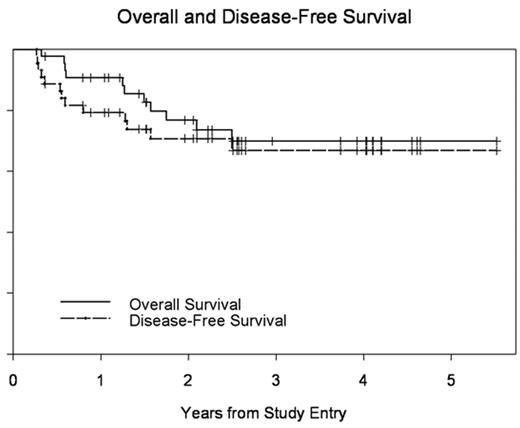Abstract
Reduced intensity allogeneic stem cell transplantation has been used increasingly to treat patients with both aggressive and indolent diseases such as low grade NHL and CLL. Most reports have consisted of single institution or registry data. We report here a prospective Cooperative Group study by CALGB in which 45 patients were treated at 11 CALGB institutions.
Methods: Patients < 70 years of age with a matched sibling donor and recurrent or refractory low grade NHL or CLL, high-risk CLL in first remission, mantle cell lymphoma or prolymphocytic leukemia were eligible. Patients were required to have CrCl > 40, DLCO > 40%, RNEF > 30% and LFTs < 3 × ULN. Disease must have been stable or responsive to the most recent previous therapy. The preparative regimen included 30 mg/m2 fludarabine × 5, and 1 gm/m2 cyclophosphamide × 3. The graft was G-CSF mobilized PBSC, and tacrolimus and low-dose MTX (5 mg/m2) on days 1,3,and 6 was used for GVHD prevention. Tacrolimus was tapered from day +90 to +150 in the absence of GVHD. Standard infectious disease prophylaxis, supportive care, and G-CSF from day +5 to engraftment were employed. DLI was given for stable or progressive disease, not loss of chimerism alone.
Results: 47 pts were enrolled with 44 eligible and evaluable; median age 53; 23 NHL, 14 CLL, 2 PLL, 4 mantle cell and one unknown. 27% developed ≥ grade 2 acute GVHD and 47% (18% extensive) chronic GVHD. TRM at 6 months was 2% and was 7% overall. Mortality at 2.6 year f/u is 25% due to GVH, sepsis, or 2nd malignancy (9%) and progressive disease (7 pts,16%). Estimated 2 yr DFS is 71% (CI 54–82) and OS is 76% (CI 60–87). Grade 4 AEs included 4 pneumonia/ pneumonitis, 1 PE, 1 VOD and 1 second malignancy (pancreatic CA). Documented infectious events included 32% viral, 41% bacterial, and 20% fugal. For T cell (CD3), the median chimerism at day 180 was 98% and 99% in peripheral blood and bone marrow; > 90% chimerism was present in 64% and 66% respectively. For unfractionated, the median chimerism at day 180 was 99% and 98% in peripheral blood and bone marrow; > 90% chimerism was present in 65% and 70% respectively.
Conclusion: These encouraging results indicate that a high CR and DFS rate can be obtained with low TRM without use of anti-CD20 therapy in a Cooperative Group trial of matched related allogeneic transplant in patients with low grade NHL or CLL. Appropriate patients should be considered for such therapy when standard treatments are no longer capable of achieving prolonged remissions.
Overall and Disease-Free Survival
Author notes
Disclosure:Off Label Use: Use of fludarabine and cyclophosphamide as a component of the conditioning regimen for alogeneic transplantation.


This feature is available to Subscribers Only
Sign In or Create an Account Close Modal